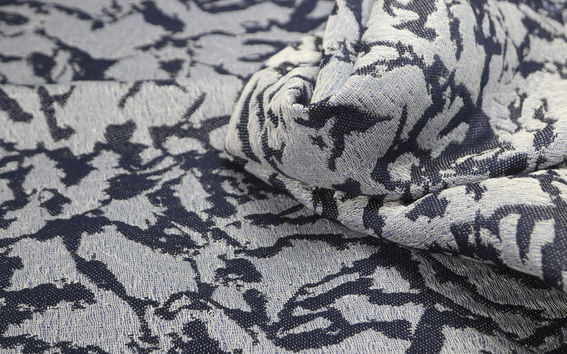Aalto University’s fashion studies are enhanced by a strong expertise in textiles

Students of fashion and clothing design at the School of Arts, Design and Architecture have been successful in international fashion competitions and have been attracting the attention of international fashion professionals for many years. In addition to visionary collections, the students' extensive textile expertise has been noticed.
‘We maintain a really strong connection between textile design and fashion in our teaching. Our students learn in parallel both textile and clothing design. The students design and produce many of the materials for their collections, which are seen at the annual fashion show Näytös’, said Maarit Salolainen, professor of textile design.
Students have the opportunity to design their own printed, woven, and knitted fabrics for their collections. This experience becomes a strong asset in working life when many of Aalto's fashion graduates begin work in fashion houses, specifically in the textile design area, for example as knit or print designers. Teachers encourage students to work with textiles, and therefore Aalto's graduate fashion designers have a strong understanding of materials and their properties. This knowledge also provides them with the skills to work in a variety of roles in the workplace.
‘Our work is always based on a strong artistic concept or solving a design problem, but it is equally important to have a thorough understanding of textile techniques. We focus on understanding woven and knitted structures and mastering finishes, such as dyeing', said Maija Fagerlund, lecturer of textile design.
There is a lot of multidisciplinary cooperation in textile design between Aalto University schools. Good examples of this are the CHEMARTS and the Experimental Textile Design Module.
Textile design lecturer Anna-Mari LeppisaariCompanies where our students have internships often comment that they have a very good combination of both artistic and technical skills."
Versatile studios and new equipment
On an international scale, the school's studios - workshops - and equipment are versatile and even unique. Many of the workshops have equipment and capabilities that are essential to working in the industry. At the workshops the students can experiment with different materials, methods and processes.
‘Many schools in the world do not have this kind of combination of teaching and equipment. We can be proud of our great machines, such as our industrial jacquard weaving machine’, Maarit Salolainen said. ‘In textile design, technical expertise and the understanding of machines seamlessly link to artistic design expertise. The equipment and techniques are our artist's palette.’ Fabrics woven with Aalto’s brand-new jacquard weaving machine were seen for the first time at the annual fashion show, which was held at the end of May.
Use of the diverse studios enables the design of multidimensional and high-quality artistic textiles. Students are also encouraged to take advantage of textile workshops and techniques in parallel, for example, to further work on woven or knitted fabrics in a print studio.
Well-equipped studios allow for in-depth learning of textile techniques. Students can manufacture their own fabrics using processes similar to those used in the industry, thus learning the possibilities and limitations of techniques in practice.
Both industrial machines and hand-tools that are suitable for different stages of learning are available. For example, when knitting by hand you will learn to understand how woven fabric is constructed and how different yarn materials affect the structure. Modifying your design for an industrial machine then teaches you to understand the requirements of industrial weaving. This also enables weaving of larger quantities, for example, for clothing collections or upholstered furniture.
‘Our studios are not just a collection of equipment, but importantly they enable the teaching of artistic design expertise. Us teachers work closely with workshop masters, and in addition to a range of equipment we strive to offer an array of interesting new yarns and printing bases and methods‘, said textile design lecturer Anna-Mari Leppisaari.
Students are also taught how to use programs for textile design, such as the M1plus pattern program and the Weavepoint woven fabric program. The programs make it possible for the students to design and develop models independently and experiment freely. In addition, Maija Fagerlund has developed Photoshop methods for designing woven fabrics, which enables students to design jacquard fabrics with an easy-to-access program that is available for them even after they move on to working life.
‘Companies where our students have internships often comment that our students have a very good combination of both artistic and technical skills. Although the main focus in our teaching is on artistic design expertise, students interested in textile product development can deepen their design skills through learning to master these special programs’, Leppisaari said.
In October this year, a book called 'Interwoven - Exploring Materials and Structures' written by Salolainen will be published. Fagerlund and Leppisaari have also written sections to the book. The book presents the pedagogical platforms and design process concepts behind the textile and especially woven fabric design at Aalto. In this way, collected learnings and best practices from Aalto are shared with the world.
Casual knits with a twinkle in the eye

Eerika Yli-Rahko's collection includes woven and printed fabrics and dyed silk organza. This year, the Näytös fashion show included her bachelor's thesis collection. She made all the materials for the collection herself. The knits have been made using ADF machinery as well as by hand, and textiles have been further processed in the printing studio.
‘The school offers endless opportunities. It is great that you don't have to complete things in one studio, but you can continue to work on them in different studios. Here at Aalto you are encouraged to experiment, you don't have to do things according to the manual’, Yli-Rahko said.
Her men's clothing collection is based on men’s casual fashion. She studied the silhouettes of the 1920’s and 1930’s men's suits and the relaxation of men's fashion, which was typical of the era between the World Wars. For example, at that time, sports fashion started to emerge and men’s everyday clothing began to be strongly influenced by it.
Yli-Rahko's design identity and perspective on fashion is relaxed, with a little twinkle in the eye. She wants to continue working with knits, which she feels are the most natural choice for her. She is completely at ease with the related technical expertise, as well as the knitting and sewing work.
‘Here you gain a really good and solid knowledge base for everything and learn how to work in the studios, in a comprehensive and in-depth way. It is all just down to your own activity. Help and information are always available, and every studio has some really cool workshop masters’, Yli-Rahko said.
Everyday patterns and wrap-around jersey

This spring's Näytös fashion show also featured Netta Törmälä's master's thesis collection. In her collection Törmälä utilised a printing studio and a weaving studio and developed woven fabrics so that the materials would work optimally and produce the desired results in the printing studio. She finished the woven fabrics by painting, printing and etching, as well as combining all of these techniques.
'These opportunities encouraged me to produce textiles in a way that their most interesting visual features come from parallel processes, and it would not have been possible to implement them in just one studio’, Törmälä said.
Her collection was inspired by the 70's everyday Finnish home textile patterns, works by Katharina Grosse, underwear and dressing gowns, and Halston's 70's wrap-around jersey clothing.
Törmälä praises the quality of textile design and clothing design teaching at Aalto University. ‘From the very beginning we are encouraged to start learning the creative process rather than just starting with technical basics. Technical skills are acquired as the studies progress. This approach increases student motivation and, at least for me, was an important factor that made me interested in textile design’, said Törmälä.
She feels that teachers are motivated to help students find their own ways of working and tools that best support self-expression. Workshop masters also play an important role.
‘They are very committed to helping students develop solutions for even the wildest ideas. All the great equipment wouldn’t be useful without them. Not once during the course has there been a situation where an idea has not been experimented on because it was deemed impossible.'
Exploring weave structures in interior textiles

Leonardo Hidalgo Uribe designs interior textiles. For his collection he has been working at the printing, dyeing and weaving studios. 'The studios have offered incredible facilities to develop my designs because of the versatile equipment and availability of working time. I have been lucky to be able to use the brand new industrial jacquard loom where I can produce my woven fabrics as well as do quick tests', he explains.
Inspiration for his design and collection is based on personal narratives of his family and their journeys around the country. His jacquard collection 'Stories from warm and cold lands' features his mother's journey in her childhood with her parents, reaching from the mountains of the center of Hidalgo Uribe’s homeland Colombia, to the Caribbean coast on the north. Hidalgo Uribe designed jacquard patterns and explored how to create multilayered weave structures that could appeal to the complexity of the surfaces of the journey.
His background in woven fabrics before starting at the Aalto Master's programme for Fashion Clothing and Textile Design included only elementary skills in handweaving, mostly using plain weave. In less than a year, he says, he managed to gain an understanding of designing complex structures for both shaft looms and jacquard looms.
'It’s been an intense experience for me. Especially in the case of woven fabrics design the learning curve I experienced was dramatic. All in all, I have developed a great set of technical and creative skills', he rejoices.
'Most importantly, this knowledge has been related to textile industry from the beginning. It has been essential for me to learn about industrial manufacturing processes for both weaving and printing and to be able to design for these technologies', Hidalgo Uribe describes his experiences in Aalto.
Hidalgo Uribe thinks working with real clients – such as is done in the PatternLab course – has been a great experience for learning not only about the role of a freelance textile designer, but also of a design studio team member. Furthermore, the first year of master’s studies in Aalto has offered an important experience: being able to work both individually and in teams, learning from the classmates and having a 'we all grow together' environment.
Read more news

Study: Internal combustion engine can achieve zero-emission combustion and double efficiency
A new combustion concept that utilizes argon could completely eliminate nitrogen oxide emissions from internal combustion engines and double their efficiency compared to diesel engines.
A new way to measure contagion: the gut bacterium behind blood poisoning can spread like influenza
Neither the antibiotic-resistant nor the highly virulent strains are the most transmissible.Tonmoy Saha Presents Textile Recycling Research at CIMANET Seminar
The CIMANET Research Seminar, held under the theme “Future Leaders in Circular Materials Bioeconomy,” took place on Thursday, December 4, at the Scandic Marina Congress Center in Helsinki.






